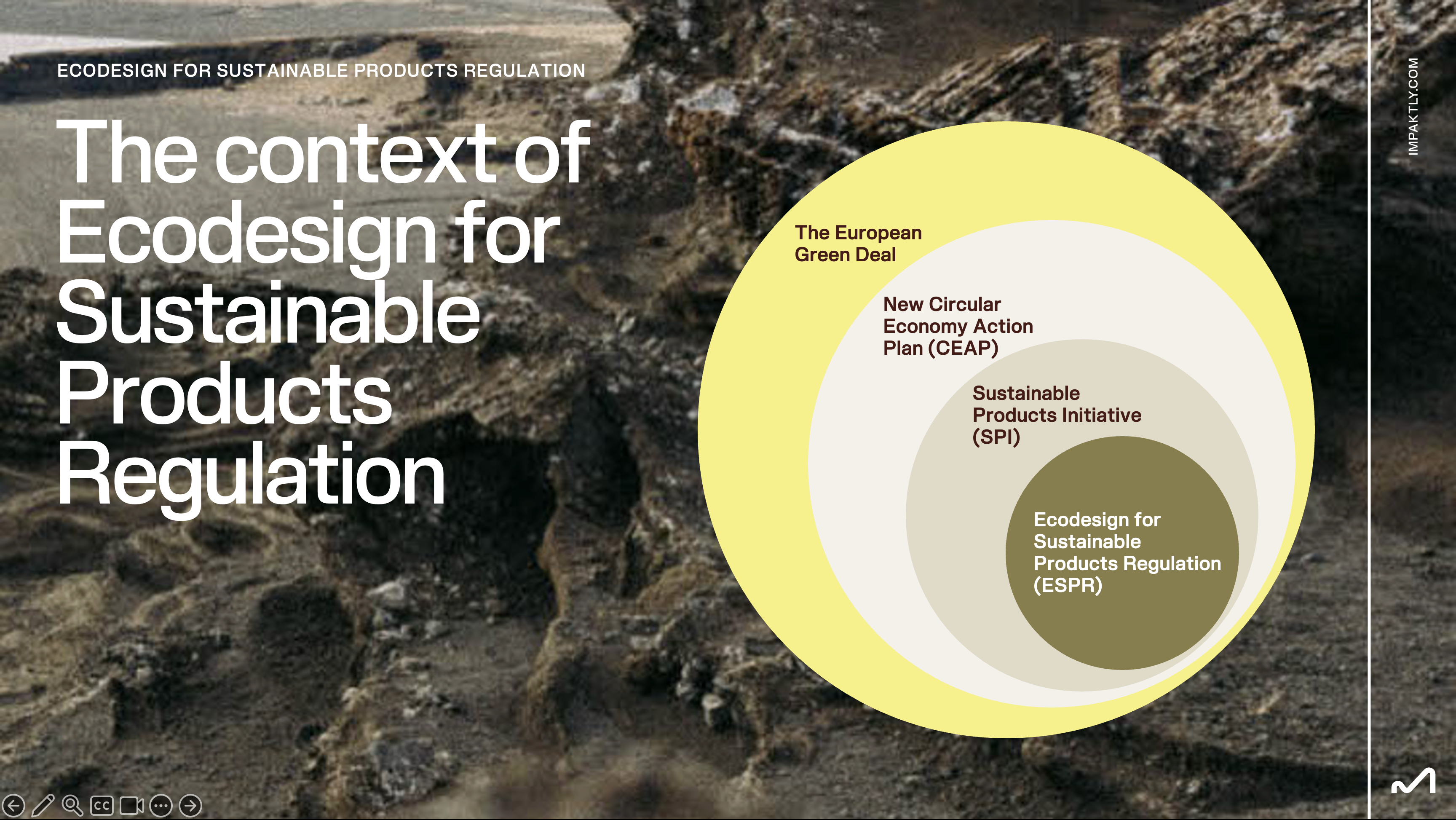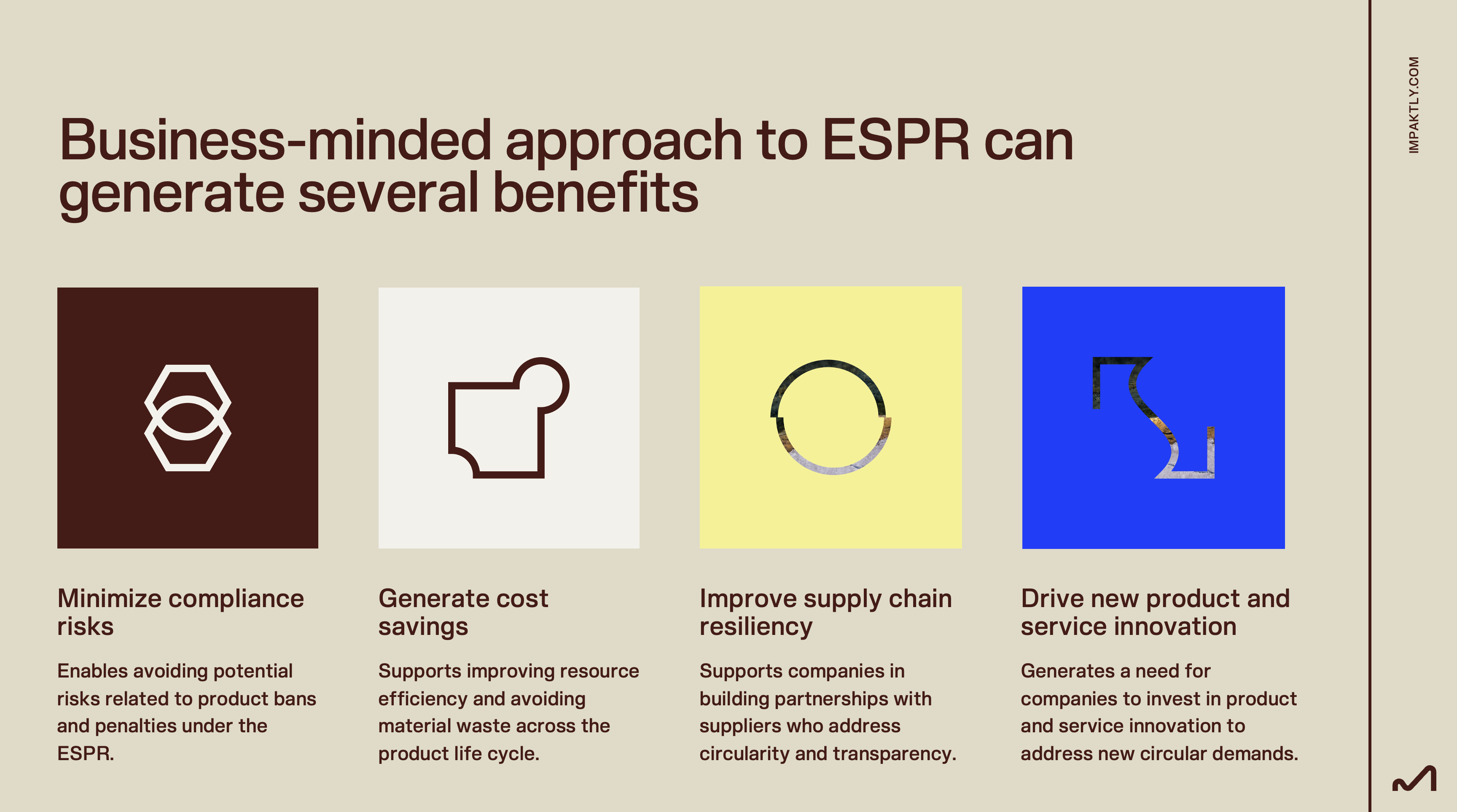6 February 2025
The Ecodesign for Sustainable Products Regulation: Advancing Circularity in the European Union
Antti Maunula
Head of Regulatory Services
6 February 2025
The Ecodesign for Sustainable Products Regulation: Advancing Circularity in the European Union
Antti Maunula
Head of Regulatory Services
The key objective of the European Green Deal is to transition to a circular economy with the objective of making Europe cleaner and more competitive. The Circular Economy Action Plan has been formulated to guide circularity efforts, and the Ecodesign for Sustainable Products Regulation (ESPR) is one of the key initiatives within this plan.
In this blog post, we’ll explore the key aspects of the Ecodesign for Sustainable Products Regulation and what is the current state in its implementation.
What is the Ecodesign for Sustainable Products Regulation (ESPR)?
The ESPR is designed to improve product sustainability and increase related transparency by setting performance and information requirements for products sold in the EU market. Only a few exemptions may apply, for example, for food and feed and medicinal products.
The ESPR gradually replaces the Ecodesign Directive 2009/125/EC and establishes a framework for setting ecodesign requirements on specific product groups. The ESPR extends the Ecodesign Directive in two ways:
Extension of product coverage: While the Ecodesign Directive has applied only to energy-related products, the ESPR extends this scope to cover virtually all physical products. Only a few exemptions apply, for example, for food and feed, and medicinal products.
Extension of the range of requirements: The ESPR reinforces the range of ecodesign requirements that can be set for products, which can comprise requirements relating to durability, circularity and the overall reduction of the environmental and climate footprint of products, amongst many others.
Introduction of Digital Product Passport (DPP): DPP is a digital identity card for products, components, and materials, which will store relevant information to support products’ sustainability, promote their circularity and strengthen legal compliance.
Ban on Destruction of Unsold Consumer Goods: To combat waste, the regulation will prohibit the destruction of unsold consumer products, such as textiles and electronics. Companies will be required to donate, recycle, or repurpose excess stock instead of sending it to landfills or incineration.

What type of ecodesign requirements can be expected?
The actual ecodesign requirements will be defined based on product group specific working plans and the European Commission will define prioritization and timeline based on the assessment of product groups’ environmental impacts. The ecodesign requirements can include product group specific performance and information rules as well as horizontal rules spanning across several product groups.
The performance and information rules can include:
Improving product durability, reusability, upgradability and reparability
Enhancing the possibility of product maintenance and refurbishment
Making products more energy and resource-efficient
Addressing the presence of substances that inhibit circularity
Increasing recycled content
Making products easier to remanufacture and recycle
Setting rules on carbon and environmental footprints
Limiting the generation of waste
Improving the availability of information on product sustainability
What is meant by the Digital Product Passport?
Digital Product Passport (DPP) is a digital identity card for products, components, and materials. It will store relevant information to support products’ sustainability, promote their circularity and strengthen legal compliance. The information will be accessible electronically (e.g. through a bar code, QR code, or another data-capture medium). It will also allow custom authorities to perform automatic checks on the existence and authenticity of the DPPs of imported products. The information requirements will depend on the specific product in question. Information expected in the Digital Product Passports can include:
Product’s technical performance
Materials and their origins
Repair activities
Recycling capabilities
Lifecycle environmental impacts
How will the development of the ecodesign requirements progress?
In November 2024, the Joint Research Center (JRC) of the European Commission published a study on product priorities, which identified 18 product groups and three horizontal requirements (Durability, Recyclability, Recycled content) as potential priorities to be considered in first ESPR working plans. The potential product priorities identified are as follows:
Intermediate products: Iron and steel, commodity chemicals, non-ferrous and non-aluminium metals, aluminium, plastics and polymers, pulp and paper, and glass
Final products: Textiles and footwear, furniture, tyres, bed mattresses, detergents, paints and varnishes, lubricants, cosmetics, toys, fishing gear, and absorbent hygiene products.
An Ecodesign Forum is established to setting the mandatory performance and information requirements. The Ecodesign Forum is an expert group and the participants include experts appointed by the Member States, representatives from industry, representatives from Academia, and representatives from civil society. The first ESPR working plan is expected in 2025.
What does ESPR mean for the business?
The ESPR means new regulatory requirements to comply with, however, it can be also an opportunity to drive cost efficiencies, improve supply chain resilience and identify new business opportunities. The new business opportunities enable both B2C and B2B brands to build more meaningful customer experiences across the product’s life-cycle. Repair, re-sell, or refurbishing services allow brands to build cyclical relationships instead of linear ones. Tapping into the opportunities will require businesses to redesign their business models, the customer journey, and also think about the branding and communications.

What can be done before the exact ecodesign requirements are published?
To prepare for the ESPR, we recommend companies to ensure that key teams in the organization (e.g. product design & management, innovation, sourcing and sustainability) are aware of the regulation, identify what type of implications could follow and monitor closely the development of the regulation.
Stay updated on the ESPR Working Plans: Monitor the development of the first working plan during 2025, setting out which products will be prioritised over the coming years. Assess the implications to your product portfolio.
Monitor the development of product rules: Stay on top the product group related requirement development and identify which areas of your portfolio and R&D process they will influence.
Evaluate potential gaps & opportunities: Build product specific plans by assessing products against the detailed performance and information requirements. Identify gaps but also commercial opportunities.
Adjust design process to consider ESPR requirements: Augment the R&D and innovation practices to consider the ESPR product requirements in order to address them effectively and consistently.
Let's talk about how to make this happen
We help you set the foundation and grow into becoming true business leaders in vast sustainability transformations.
Mia Folkesson
Managing Partner
mia@impaktly.com
Let's talk about how to make this happen
We help you set the foundation and grow into becoming true business leaders in vast sustainability transformations.
Mia Folkesson
Managing Partner
mia@impaktly.com